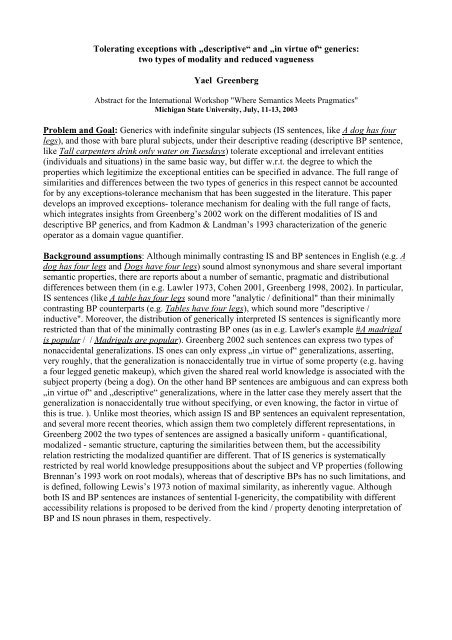SemPrag03.Progr.pdf - Institut für Linguistik/Germanistik - Universität ...
SemPrag03.Progr.pdf - Institut für Linguistik/Germanistik - Universität ...
SemPrag03.Progr.pdf - Institut für Linguistik/Germanistik - Universität ...
Create successful ePaper yourself
Turn your PDF publications into a flip-book with our unique Google optimized e-Paper software.
Tolerating exceptions with „descriptive“ and „in virtue of“ generics:<br />
two types of modality and reduced vagueness<br />
Yael Greenberg<br />
Abstract for the International Workshop "Where Semantics Meets Pragmatics"<br />
Michigan State University, July, 11-13, 2003<br />
Problem and Goal: Generics with indefinite singular subjects (IS sentences, like A dog has four<br />
legs), and those with bare plural subjects, under their descriptive reading (descriptive BP sentence,<br />
like Tall carpenters drink only water on Tuesdays) tolerate exceptional and irrelevant entities<br />
(individuals and situations) in the same basic way, but differ w.r.t. the degree to which the<br />
properties which legitimize the exceptional entities can be specified in advance. The full range of<br />
similarities and differences between the two types of generics in this respect cannot be accounted<br />
for by any exceptions-tolerance mechanism that has been suggested in the literature. This paper<br />
develops an improved exceptions- tolerance mechanism for dealing with the full range of facts,<br />
which integrates insights from Greenberg’s 2002 work on the different modalities of IS and<br />
descriptive BP generics, and from Kadmon & Landman’s 1993 characterization of the generic<br />
operator as a domain vague quantifier.<br />
Background assumptions: Although minimally contrasting IS and BP sentences in English (e.g. A<br />
dog has four legs and Dogs have four legs) sound almost synonymous and share several important<br />
semantic properties, there are reports about a number of semantic, pragmatic and distributional<br />
differences between them (in e.g. Lawler 1973, Cohen 2001, Greenberg 1998, 2002). In particular,<br />
IS sentences (like A table has four legs sound more "analytic / definitional" than their minimally<br />
contrasting BP counterparts (e.g. Tables have four legs), which sound more "descriptive /<br />
inductive". Moreover, the distribution of generically interpreted IS sentences is significantly more<br />
restricted than that of the minimally contrasting BP ones (as in e.g. Lawler's example #A madrigal<br />
is popular / / Madrigals are popular). Greenberg 2002 such sentences can express two types of<br />
nonaccidental generalizations. IS ones can only express „in virtue of“ generalizations, asserting,<br />
very roughly, that the generalization is nonaccidentally true in virtue of some property (e.g. having<br />
a four legged genetic makeup), which given the shared real world knowledge is associated with the<br />
subject property (being a dog). On the other hand BP sentences are ambiguous and can express both<br />
„in virtue of“ and „descriptive“ generalizations, where in the latter case they merely assert that the<br />
generalization is nonaccidentally true without specifying, or even knowing, the factor in virtue of<br />
this is true. ). Unlike most theories, which assign IS and BP sentences an equivalent representation,<br />
and several more recent theories, which assign them two completely different representations, in<br />
Greenberg 2002 the two types of sentences are assigned a basically uniform - quantificational,<br />
modalized - semantic structure, capturing the similarities between them, but the accessibility<br />
relation restricting the modalized quantifier are different. That of IS generics is systematically<br />
restricted by real world knowledge presuppositions about the subject and VP properties (following<br />
Brennan’s 1993 work on root modals), whereas that of descriptive BPs has no such limitations, and<br />
is defined, following Lewis’s 1973 notion of maximal similarity, as inherently vague. Although<br />
both IS and BP sentences are instances of sentential I-genericity, the compatibility with different<br />
accessibility relations is proposed to be derived from the kind / property denoting interpretation of<br />
BP and IS noun phrases in them, respectively.

















